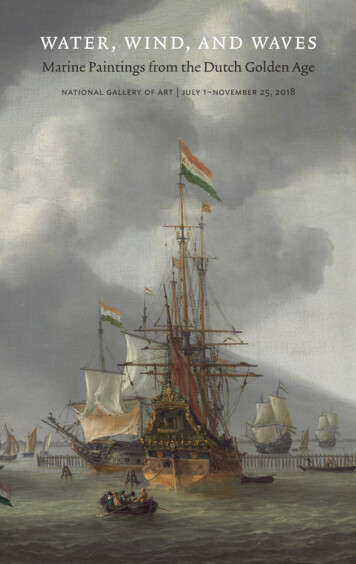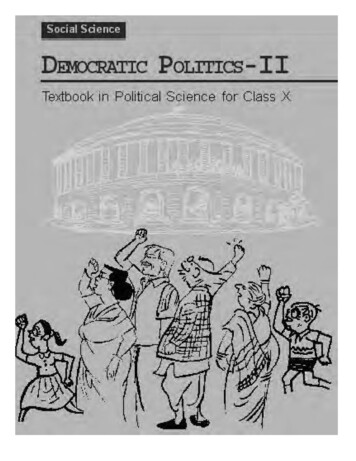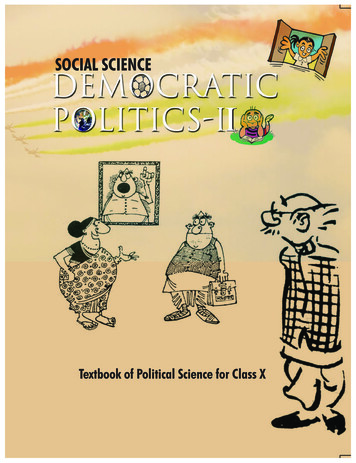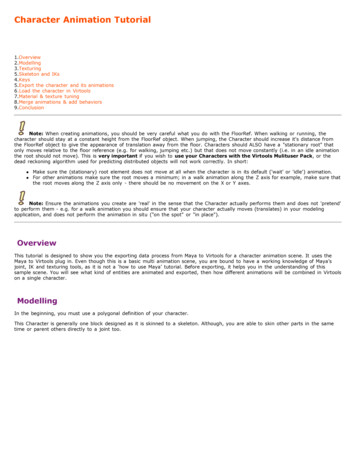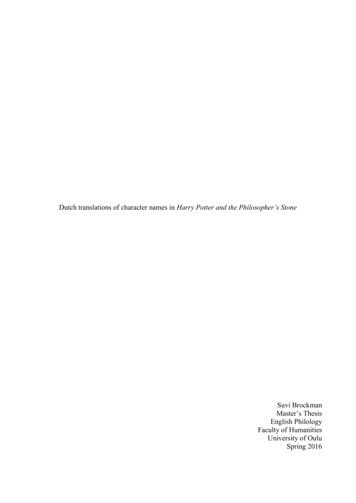
Transcription
Dutch translations of character names in Harry Potter and the Philosopher’s StoneSuvi BrockmanMaster’s ThesisEnglish PhilologyFaculty of HumanitiesUniversity of OuluSpring 2016
ACKNOWLEDGEMENTSFirstly, I would like to thank Professor Elise Kärkkäinen for supervising my thesis and instructingme along the way.Secondly, I would like to express my gratitude to my friend, Rita, for all the useful comments andthe support.Thirdly, my family has helped me a great deal during my studies, for which I am extremely grateful.Lastly and most importantly, I want to thank my fiancé, Rob, without whom I could not havecompleted this thesis.
Table of Contents1 Introduction . 12 Material and method . 33 Theoretical framework . 63.1 Literary translation . 63.1.1 Communicative translation theory . 63.1.2 Domestication and foreignisation as translation strategies . 83.1.3 Translating for children . 103.1.4 Previous research on the names in Harry Potter . 133.2 Proper names . 173.2.1 Significance . 173.2.2 Translation. 204 Dutch translations of character names in Harry Potter and the Philosopher’s Stone . 264.1 Preservation . 274.1.1 Preservation of the name’s form . 294.1.2 Preservation of the name’s meaning . 344.2 Transformation . 354.2.1 Names linked to the original . 374.2.2 Names related to the personality of the character . 404.2.3 Names spelled similarly as the original . 454.2.4 Names translated in a humorous way. 464.2.5 Names without connections to the original . 494.3 Localisation . 544.4 Creation . 595 Discussion of the findings . 626 Conclusion . 71References . 73
11 IntroductionIn this paper, the Dutch translations of names of the first Harry Potter novel, Harry Potter and thePhilosopher’s Stone, are studied. They are studied by means of careful reading and categorisationinto groups developed by Davies (2003), who used the groups for her study of culture-specific itemsin the Harry Potter series. The aim is to answer the following research questions: how have the namesbeen translated exactly and what is the translation like in comparison to other translations of namesin the novel. The topic is a worthwhile subject because the translation of names presents challengesto translators. Furthermore, I have a personal interest in the Dutch language, which makes this topicparticularly interesting to examine.The well-known Harry Potter series by a British author, J.K. Rowling, is famous for its wealth ofnames and terms coined by the writer. In the first novel alone, there are 112 characters’ names to bestudied, and many more references to the British culture including names of foods, for example.According to Davies (2003), the first novel was aimed for a British audience, which makes it aparticularly interesting topic because of the difficulties it might cause to translators (p. 66).The names have been analysed and placed into groups depending on the method used in thetranslation. The categories used by Davies (2003) were initially used for a wider group of items,namely culture-specific items, but as names are culture-specific, too, the categories may be used forthis purpose as well. In fact, Davies includes names in her study as well.This topic is worth studying because of two reasons: because of the challenging nature of this aspectof a translator’s work and because of my personal interest in the Dutch language and culture. Theimportance of names is stated in the novel as well, as Dumbledore says to Harry: “Always use theproper name for things. Fear of a name increases fear of the thing itself” (Rowling, 1997, p. 216).People use names to refer to other individuals and, in doing so, the relationship between them isrevealed. Transferring all aspects of a name into another language is extremely challenging, andstudying the solutions of different translators is important in order to discover more about translationand the differences between cultures. Several other translations of the names in the Harry Potter serieshave been studied already, for example Finnish, Danish, Swedish, Norwegian, German and Italian.However, there is little previous research dedicated to the Dutch language only, even though Davies(2003) does mention some Dutch names in her study. Additionally, as a learner of Dutch, it is
2fascinating to learn about this aspect of the culture and language and to combine my studies withpersonal interests. Writing this paper has been particularly exciting because of that.The limit of this paper is that only the names in the first Harry Potter book will be examined. However,a large number of the names appear in several or all the novels of the series. Furthermore, the namesstudied here include all of the names in the novel, together with names of minor characters and namesthat are only mentioned in the novel, for example authors of books that are a part of the story. Thatway no names have been eliminated and the full extent of the translator’s work will be examined.Another limitation is the exclusion of other culture-specific items; including them would of coursehelp discover more about the Dutch translation. However, a great deal of information can bediscovered also by examining names.The paper is constructed as follows: In the second section, the material and method will be discussed.In the third section, the theoretical framework will be explored, including the following topics:literary translation, proper names and previous research on the names in Harry Potter. The fourthsection contains the analysis and it is followed by the discussion in the fifth section. The conclusioncompletes the paper.
32 Material and methodIn this section the material used in this paper will be presented along with the method of analysis. Inaddition, the author, the novel and the Dutch translator of the novel will be introduced.The research material is from the works of J. K. Rowling, a British writer, who is the author of theHarry Potter books. According to her biography on her website, she was born Joanne Rowling in July1965 in England. Previously to her writing career, she worked as a researcher at AmnestyInternational and taught English as a second language in Portugal. She began writing in the early1990s and completed the first book, called Harry Potter and the Philosopher’s Stone, some yearslater, though it was not published until 1997. Enormous success ensued, as the second book, HarryPotter and the Chamber of Secrets became the no. 1 bestseller. By now, the whole series consistingof seven books has been published and a film adaptation has been made of each book. After the Potterseries, she has published books for adults, including a crime novel (Rowling, 2012).The novel studied in this paper is Harry Potter and the Philosopher’s Stone. The story begins with adescription of Harry Potter being delivered to his aunt and uncle after he miraculously survived adeadly attack. The relatives are forced to raise Harry with their son and the unpleasantness of the taskis not a secret. However, years later there is a turning point in Harry’s life: on his 11th birthday, Harryreceives a letter from the Hogwarts School of Witchcraft and Wizardry, and it is finally revealed tohim that he is actually a wizard – and a famous one. He is introduced to a new world, a world ofmagic, where he encounters a kind of happiness and evil he has never experienced before. As a result,he learns about magical elements in all areas of life, including a great deal of new terminology for allthe phenomena that do not exist in the regular world. The ordinary world that the reader knows iscompared and contrasted with the magical world which Harry Potter enters. In the story that follows,Harry goes to school in Hogwarts, becomes a wizard and learns about life in the magical world afterbeing brought up in the non-magical world. For example, wizards have peculiar means oftransportation, unusual foods and strange pets. During the course of the novel, Harry also fights evil,as he is the only person who has ever been able to oppose the most influential evil wizard, LordVoldemort (Rowling, 1997).The Harry Potter books have been translated into Dutch by Wiebe Buddingh’. He began histranslation career in 1980, and he has since translated several novels and children’s books, although
4Harry Potter and the Philosopher’s Stone was the first children’s book he translated (De Harmonie,2001). According to his interview on the website of the publisher, he likes reading and writing morethan talking (De Harmonie, 2001). In an interview regarding his Harry Potter translations, he said hisaim is to have the Dutch term create the same feeling as the English and that the name has the sameatmosphere as the original did and, lastly, that it feels good (Interview Wiebe Buddingh’, n.d.-a). Heusually works so that he first reads the book and makes notes of difficult names, concepts and punsand spends some time thinking about them (De Harmonie, 2001). Then he begins translating, andwhen the translation is finished, he corrects his work; many problems are solved when re-reading thetext (De Harmonie, 2001). He has also said that translating the Harry Potter series has been enjoyablefor him because of the creativity required (Interview Wiebe Budding’, n.d.-a). In the same interview,when asked what he thinks about the names being left untranslated in the French and Germantranslations, he responded that he has not seen any other translations, but that a lot of humour is boundto be lost in such a translation (Interview Wiebe Budding’, n.d.-a). Furthermore, he thinks that it isinevitable that discoveries or jokes might be lost in the translation but the translator can also add jokeswhen translating the names sometimes (Interview Wiebe Budding’, n.d.-a). As sources of names, heuses a list he has compiled of funny names in addition to dictionaries (Interview Wiebe Budding’,n.d.-b).In this thesis, by character name I mean names of the protagonists, other characters and creatures ofthe novel who may or may not affect the plot or who may only have been mentioned once in the book.In literature, the terms proper name and proper noun are often mentioned, and it should be clarifiedwhat they mean exactly. Nouns can be divided into common nouns and proper nouns: a commonnoun is “a name applicable to each of the individuals or species which make up a class” whereas aproper noun is “a noun that designates an individual person, place, organization, animal, ship, etc.,and is usually written with an initial capital letter” (Oxford English Dictionary, 2015). Furthermore,a proper name is “a name, consisting of a proper noun or noun phrase including a proper noun thatdesignates an individual person, place, organization, tame animal, ship, etc., and is usually writtenwith an initial capital letter” (Oxford English Dictionary, 2015). To put it more simply, a proper nameis a wider version of a proper noun; while a proper noun is only one word, a proper name may consistof more than one. Here is an example from the data of this paper: Gregory is a proper noun, butGregory the Smarmy is a proper name. Gregory is also a proper name, but Gregory the Smarmy isnot a proper noun because it consists of more than one word.
5A total of 112 characters’ name appear in the novel and will be studied in this paper. It should benoted, however, that some names only consist of a first name or a last name because their full nameis not mentioned in the story. The data contains all the personal names in the novel. Effort has beenmade to create and translate each name and, therefore, they all deserve to be taken into account, whichis why every name is worth examining. Because this is a series of novels, some names may beinsignificant in the first novel but might become central figures as the story progresses. The listnaturally includes the names of the protagonists and several characters that appear in many sequels,but also the names that are only mentioned in passing, for example, famous wizards and the authorsof school books that the characters study. The rest of the character names include staff and studentsof the school, politicians of the magical world, ghosts, friends and family of the protagonists as wellas paintings, i.e. characters that only exist in paintings in the novel. The names of pets and otheranimals have also been included.The analysis will be conducted through a careful reading of the names. The origin of the target textnames will be briefly examined and compared with the source text names to discover the method oftranslation, after which the names will be categorised based on what method has been used to translatethem. The categories used in this paper are the ones used by Davies (2003), who analysed culturespecific items in the Harry Potter novels. The categories are preservation, addition, omission,globalisation, localisation, transformation and creation. After analysing each name individually, anoverview of the translation will be formed, and the results of the analysis will be discussed in thecontext of each category. The overview will also include discussing the translation in the frameworkof relevant translation theories introduced in the theoretical background section. Even though I havestudied Dutch for some years, I am not yet fluent in it, which is why any problems or difficultiesdeducting the meaning of the name will be solved by consulting a native speaker of Dutch, RobGlasbergen, in order to ensure that the meaning has been understood correctly. The informant is inhis late twenties and lives and works in the south of Netherlands. He is familiar with the concept ofHarry Potter and has read all the novels except for the last one.The material and method of analysis have now been dealt with. The next section contains discussionabout the theoretical framework of this thesis.
63 Theoretical frameworkNext, the theoretical background for the thesis will be discussed. This section is divided into twoparts. Firstly, translation theories relevant for this study will be discussed as well as previous researchon the names of Harry Potter. Secondly, proper names and their translation will be explored.3.1 Literary translationThis section focuses on literary translation and translation theories. In the following sections, fourtopics will be discussed: communicative translation theory, domestication and foreignisation as wellas translating for children. Lastly, the previous research that has been done on the names in HarryPotter will be examined.3.1.1 Communicative translation theoryCommunicative translation aims at the same thing that Buddingh’ aimed at when translating HarryPotter: creating the same effect on the reader as the original text did on its readers (Interview WiebeBuddingh’, n.d.-a). However, in order to understand communicative translation, we might brieflyexamine the long history of translation studies. Ruokonen (2004) explores the history of translationtheories and explains that the two main ways of translating were discovered as early as in AncientRome: Cicero and Horace recommended translating thought by thought rather than word by word (p.64). Also known as free translating, this way of translating aims to influence the audience in a waythat is not possible using word-by-word translating (Eysteinsson & Weissbort, 2006, p. 21).Essentially, Cicero had two important ideas: firstly, word-for-word translation is inappropriate and,secondly, the text should be as fluent in the target text as possible (Kelly, 1998, p. 496). The approachwas later adopted by Jerome for the translation of the Bible in the fourth century, and his version ofthe Bible, which was called Vulgate, was only replaced in the 16th century during the reformation(Robinson, 1997, p. 23, as quoted by Ruokonen, 2004, p. 64). He wrote that translating word by wordwould result in strange language and, consequently, he avoided translating in such a manner(Eysteinsson & Weissbort, 2006, p. 29). On the other hand, Jerome also stated that because the Bibleis holy, even the sentences are holy, and they should be translated as accurately as possible
7(Ruokonen, 2004, p. 65). Nevertheless, the Roman translating tradition of sense-for-sense translatinghas influenced the translation theories greatly until the 16th century (Kelly, 1998, p. 496).Another influential translator was Luther, who continued the tradition of free translation bytranslating texts to fit the target culture norms; it was important to make them easy to understand forthe target language readers while translating as accurately as possible in order to preserve the meaningof the text (Ruokonen, 2004, p. 65). He was, after all, translating for people with no reading skills ofLatin, Greek or Hebrew; therefore, his general principle was to translate freely, and to only resort toword-for-word translation for teaching purposes regarding theological facts (Kittel & Poltermann,1998, p. 421). However, during the Romantic era in Germany, people started to criticise such anapproach, and it became ideal to translate as accurately as possible and to preserve the conventionsof the source text, and the translator was supposed to renew the target language by transferring newconstructions to the language from the source language (Ruokonen, 2004, p. 66). Schleiermacher, forexample, encouraged translators to write so that the reader would be aware of the translation all thetime and to retain the source text elements, arguing that they are not mathematical characters whoseorder can be altered without any change in the result (p. 67). He opposed the domesticating translatingstyle, i.e. changing the language to suit the target culture conventions (p. 67).More recently, Newmark (1988) has considered the sense-for-sense theory and developed his own,called communicative translation. The reader of a text translated in this way expects the content to beadapted to the target culture (p. 39). It is more important to make the text understandable for the targettext readers than to make the translation match the original. The following is an example wherecommunicative translation is followed: the German phrase Bissiger Hund translated into Beware ofthe dog would be more suitable than Dog that bites or Biting dog, which it literally means (p. 39).The context has been taken into account and the translator has arrived to the conclusion that thedesired effect on the reader is that the dog is possibly dangerous. It is not essential that the dog bites,but that one should take care when encountering the animal in question. Additionally, in Newmark’sview the translator is allowed to change the text when aiming for a communicative translation,correcting mistakes and removing obscurities as well as improving the logic of the text (p. 49).The thoughts of Buddingh’ seem to be in line with those of Newmark (1988). In an interview,Buddingh’ stated that his aim is to produce a translation that has the same effect on the reader as theoriginal work did, which is also the aim of communicative translation (Interview Wiebe Buddingh’,
8n.d.-a). Furthermore, Buddingh’ has also said that because jokes are inevitably lost when translating,the translator is allowed to add other jokes elsewhere (Interview Wiebe Budding’, n.d.-a). Thiscoincides with Newmark’s opinion. Furthermore, it would seem that the enjoyment of the readers ismore important to Buddingh’ than translating as accurately and faithfully as possible, a view sharedby Cicero, for example (Ruokonen, 2004, p. 64).3.1.2 Domestication and foreignisation as translation strategiesFrom the sense-for-sense and word-for-word techniques, translation has proceeded to foreignisingand domesticating, which would seem to be the predominant viewpoints in translation studies in the20th century. This distinction was comprehensively discussed by Venuti (1998), whose worksBassnett (2014) considers useful because it shows the importance of translation as “an instrument ofcultural exchange” (Bassnett, 2014, p. 48).Domestication means that the source text is adapted to conform to the target culture and that thetranslator attempts to stay in line with current publishing trends and cultural values of the targetculture (Venuti, 1998, p. 240). Van Wyke (2013) calls this the author-to-reader strategy because, ina way, the translator brings the author to the reader by changing the text to appear as if written in thetarget culture (p. 549). It was a lecture given by Schleiermacher in 1813 that gave Venuti the idea ofthe two strategies (Bassnett, 2014, p. 47). Schleiermacher believed that the language would beenriched by “retaining the signs of the otherness of the original” (p. 47).Texts where domestication has been used have the appearance of an original work, as if they havenot been translated at all. By quoting several reviews of translated texts, Venuti (2008) shows thatfluent translations are highly appreciated, although usually the fact that it is a translated work is noteven mentioned in reviews (p. 2). If the translator is indeed invisible, as Venuti puts it, and the textreads as if it was originally written in the language of the target culture, in Venuti’s opinion it violatesthe source culture and highlights the predominance of the target culture instead (Bassnett, 2014, p.48). Essentially, Venuti claims that too much domestication causes readers to forget that the text is atranslation and thus it gives them a false impression of a world where there are not many culturaldifferences.
9Foreignising, on the other hand, would bring the reader to the author by signifying “the differencesof the foreign text, yet only by disrupting the cultural codes that prevail in the translating language”(Venuti, 2008, p. 15). Because foreignisation stretches the language and the conventions of the targetculture, so to speak, the text might be alienating, but reading such a text would increase awareness ofother cultures and it could therefore be used as a way to resist ethnocentrism and racism (p. 16).Perhaps this could be a small factor in increasing tolerance of foreign cultures. Texts where the readeris made to travel to the author force the reader to explore and discover new cultures. According toVenuti, foreignisation is common in Europe, but less so in British and American cultures, and sochanging this aspect might reduce the hegemony of English (p. 16).Like Venuti, Hagfors (2003) and Yamazaki (2002) also argue against domestication, but on a morespecific level. Regarding children’s literature, Yamazaki suggests that changing names, for example,“not only shows a lack of respect toward other cultures but also deprives child readers of the chanceto realize the wealth of cultural diversity that surrounds them” (p. 53). According to her, translationis not purely a linguistic matter; it reveals and affects the relationship between two cultures (pp. 53–54). If foreign cultures were familiar from an early age, people would not perceive them as distantand unusual (p. 60). For that reason, she supports Venuti’s ideas about using foreignisation to reduceracism.Similarly, Hagfors (2003) considers foreignisation a tool with which to learn about different culturesand conventions, and stresses that domesticating may result in inconsistent and confusingtranslations: In Heja, Pelle Svanslös by Gösta Knutsson, a French girl escapes the misery of post-warFrance to a welfare state, Sweden, but in the Finnish translation the place was domesticated and,instead of Sweden, the girl escapes to Finland, which had suffered from the war as much as France(p. 126). Perhaps it does not confuse a child, but adults might certainly be puzzled by suchinconsistencies. Such a translation may also give a false impression of historical events. Additionally,Hagfors establishes that the purpose of literature is to broaden our minds in addition to entertainingus, and that is why it would be desirable that the texts retained some of their original, foreign qualities(p. 125). Culture-bound elements reflect the culture and atmosphere of the original story, anddomesticating them might change the reading experience; identifying with the characters may bemore difficult and the charm of the book might be lost (p. 118).
10Oittinen (1997), on the other hand, argues that names should be translated into the target language inorder for parents to be able to read stories to their children more easily (p. 52). However, she stillagrees with Venuti in that something should be done to increase translators’ visibility (p. 121).According to her, one possible solution to the problem would be prefaces or forewords, and sheencourages translators to write them even though it is currently not a common practice (p. 121). Inaddition to making readers more aware of translators, prefaces would also be significant in providinginformation to the reader about the translation and reasons behind the choices (Nord, 1991, as quotedby Oittinen, 1995, p. 49). Yamazaki (2002) comments that the preface by the author of Emil und dieDetektive is what made the book special to her as a child, and the fact that it had been omitted fromthe English translation made her sad (p. 54).In contrast to Venuti, Bassnett (2002) discusses the remarks by Belloc (1931), who supports the ideasof domestication (Bassnett, 2002, p. 117). Bassnett summarises Belloc’s thoughts by saying that “thetranslator [of a prose text] has the right to significantly alter the text in the translation process”(Bassnett, 2002, p. 117) with the aim of producing a text that conforms to the norms of the targetlanguage. However, Belloc made his comments over 80 years ago, and it might be reasonable toassume that the norms of translation have changed. For example, Hagfors (2003) writes that in the1940s and 1950s it was common to domesticate names in Finland because there was little knowledgeof other cultures after the war, which is understandable, but nowadays there is no reason to avoid theforeign elements in the stories because people know more about foreign cultures and, moreover, areeager to learn new things about them (p. 125). Contact with other cultures is increasingly necessarydue to globalisation and it would be an advantage to have other cultures presented in literature. Onthe other hand, Belloc (1931) emphasises that a text should be considered as a whole for the processof translation, and that translating sentence by sentence will result in bad translations (Belloc, 1931,as quoted by Bassnett, 2002, pp. 116–117).3.1.3 Translating for childrenNext, the translation of children’s books will be discussed. Because they are quite different fromliterature meant for adults, they need to be approached in another way. They might include a lot ofpictures, for example, and might be made for different purposes, for example educational purposes,because the target group is so much younger and in a different phase of life compared to adults. Inher article about translating children’s literature, O’Sullivan (2013) draws attention to the aspects that
11separate it from other forms of literature and how these may affect the translation. Firstly, she notesthat children’s literature is not a homogenous body of texts and, secondly, it is parents and otheradults who choose what children read or are read to, not children themselves (pp. 451–452). Thirdly,children’s literature belongs simultaneously to the literary and socio-educational systems, whichmeans that translators have to be aware of the source culture norms taught in the books and how totranslate
Harry Potter and the Philosopher's Stone was the first children's book he translated (De Harmonie, 2001). According to his interview on the website of the publisher, he likes reading and writing more than talking (De Harmonie, 2001). In an interview regarding his Harry Potter translations, he said his
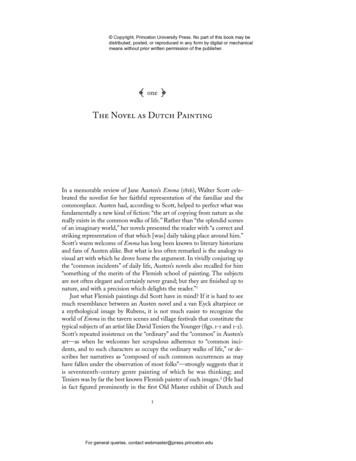

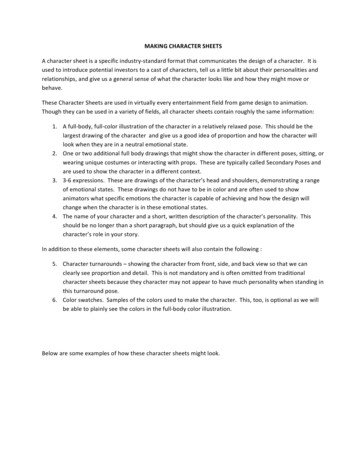
![What's in a Name? Book of Mormon Language, Names, and [Metonymic] Naming](/img/33/whats-in-a-name-book-of-mormon-language-names-and-metonymic.jpg)


